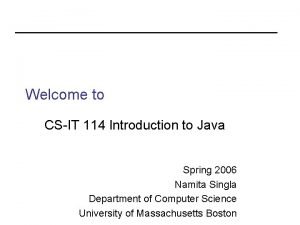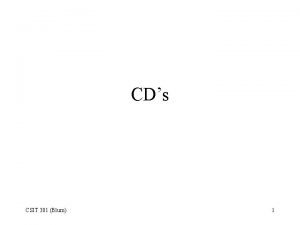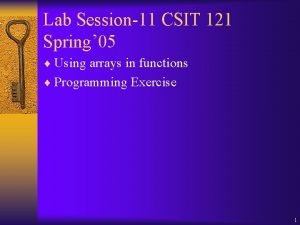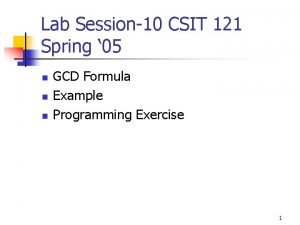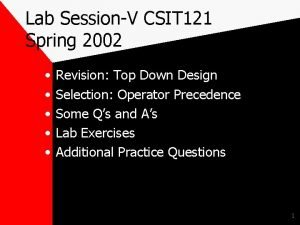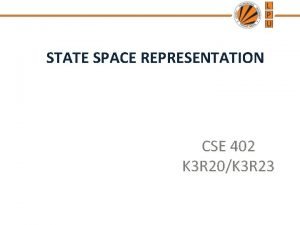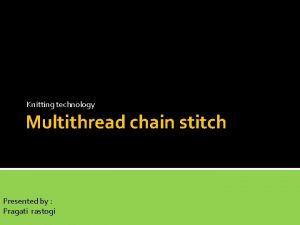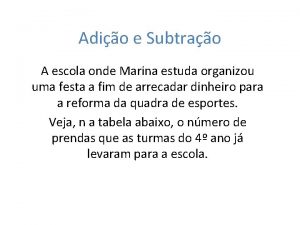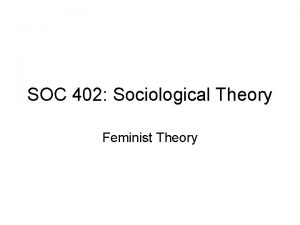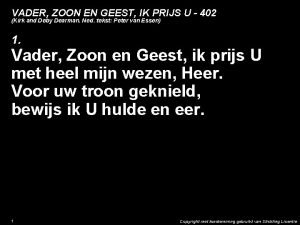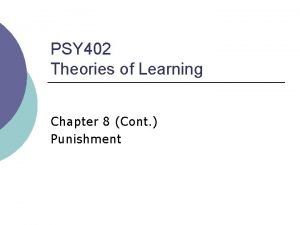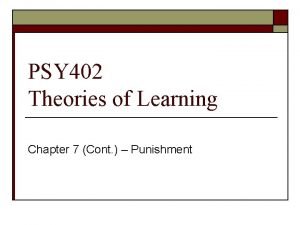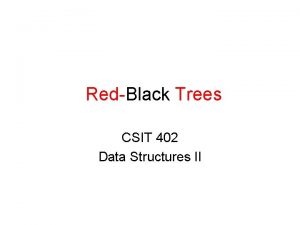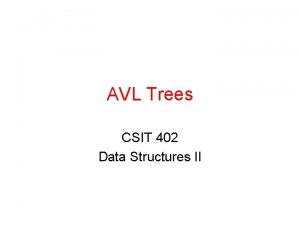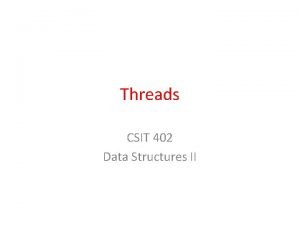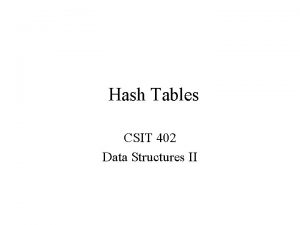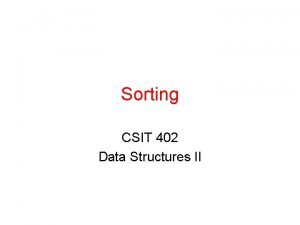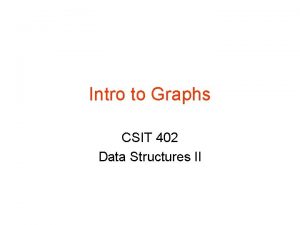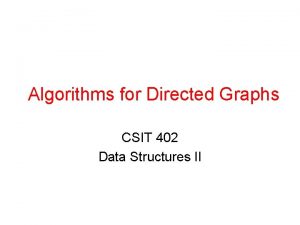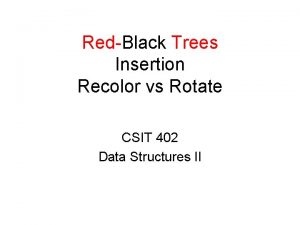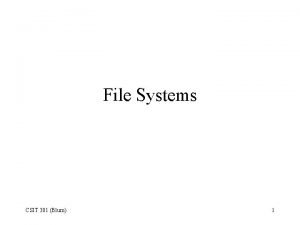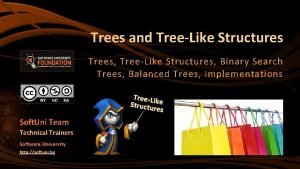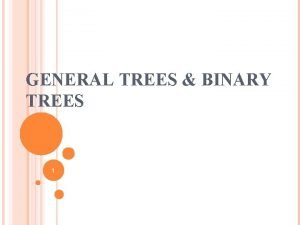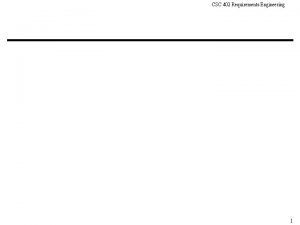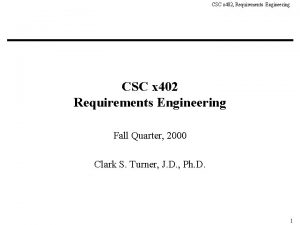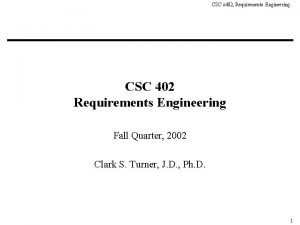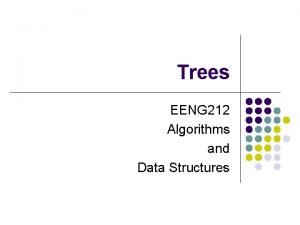Trees CSIT 402 Data Structures II 1 Why




























- Slides: 28

Trees CSIT 402 Data Structures II 1

Why Do We Need Trees? • Lists, Stacks, and Queues are linear relationships • Information often contains hierarchical relationships › File directories or folders › Moves in a game › Hierarchies in organizations • Can build a tree to support fast searching 2

Tree Jargon • root • nodes and edges • leaves • parent, children, siblings • ancestors, descendants • subtrees A C B E D F • path, path length • height, depth 3

More Tree Jargon • Length of a path = number of edges • Depth of a node N = length of path from root to N • Height of node N = length of longest path from N to a leaf • Depth of tree = depth of deepest node • Height of tree = height of root depth=0, height = 2 A C B E D F depth=1, height =0 depth = 2, height=0 4

Definition and Tree Trivia • A tree is a set of nodes, i. e. , either › it’s an empty set of nodes, or › it has one node called the root from which zero or more trees (subtrees) descend • Two nodes in a tree have at most one path between them • Can a non-zero path from node N reach node N again? › No. Trees can never have cycles (loops) What kind of a graph is a tree? 5

Paths • A tree with N nodes always has N-1 edges (prove it by induction) Base Case: N=1 one node, zero edges Inductive Hypothesis: Suppose that a tree with N=k nodes always has k-1 edges. k Induction: Suppose N=k+1… +1 The k+1 st node must connect to the rest by 1 or more edges. If more, we get a cycle. So it connects by just 1 more edge 6

Implementation of Trees • One possible pointer-based Implementation › tree nodes with value and a pointer to each child › but how many pointers should we allocate space for? • A more flexible pointer-based implementation › 1 st Child / Next Sibling List Representation › Each node has 2 pointers: one to its first child and one to next sibling › Can handle arbitrary number of children 7

Arbitrary Branching A A C B E B D C E F D Nodes of same depth F Data First. Child Sibling 8

Binary Trees • Every node has at most two children › Most popular tree in computer science • Given N nodes, what is the minimum depth of a binary tree? (This means all levels but the last are full!) › At depth d, you can have N = 2 d to N = 2 d+1 -1 nodes 9

Maximum depth vs node count • What is the maximum depth of a binary tree? › Degenerate case: Tree is a linked list! › Maximum depth = N-1 • Goal: Would like to keep depth at around log N to get better performance than linked list for operations like Find 10

A degenerate tree 1 A linked list with high overhead and few redeeming characteristics 2 3 4 5 6 7 11

Traversing Binary Trees • The definitions of the traversals are recursive definitions. For example: › Visit the root › Visit the left subtree (i. e. , visit the tree whose root is the left child) and do this recursively › Visit the right subtree (i. e. , visit the tree whose root is the right child) and do this recursively • Traversal definitions can be extended to general (non-binary) trees 12

Traversing Binary Trees • Preorder: Node, then Children (starting with the left) recursively + * + A B C D + D * + • Inorder: Left child recursively, Node, Right child recursively A + B * C + D A B • Postorder: Children recursively, then Node C AB+C*D+ 13

Binary Search Trees • Binary search trees are binary trees in which › all values in the node’s left subtree are less than node value › all values in the node’s right subtree are greater than node value • Operations: › Find, Find. Min, Find. Max, Insert, Delete What happens when we traverse the tree in inorder? 9 5 94 97 10 99 96 14

Operations on Binary Search Trees • How would you implement these? › Recursive definition of binary search trees allows recursive routines 5 › Call by reference helps too • • • Find. Min Find. Max Find Insert Delete 9 94 97 10 99 96 15

Binary Search. Tree 9 9 5 5 94 10 97 10 96 94 96 data 99 left 97 99 right 16

Find(T : tree case { T = null T. data = T. data > T. data < } } pointer, x : element): tree pointer { : x x x return null; : return T; : return Find(T. left, x); : return Find(T. right, x) 17

Find. Min • Design recursive Find. Min operation that returns the smallest element in a binary search tree. Find. Min(T : tree pointer) : tree pointer { // precondition: T is not null //. . . } 18

Insert Operation • Insert(T: tree, X: element) › Do a “Find” operation for X › If X is found update (no need to insert) › Else, “Find” stops at a NULL pointer › Insert Node with X there • Example: Insert 95 94 ? 97 10 96 99 19

Insert 95 94 94 97 10 96 96 99 99 95 20

Insert Done with call-byreference Insert(T : reference tree pointer, x : element) : integer { if T = null then T : = new tree; T. data : = x; return 1; //the links to //children are null case T. data = x : return 0; This is where call by T. data > x : return Insert(T. left, x); T. data < x : return Insert(T. right, x); reference makes a endcase difference. } Advantage of reference parameter is that the call has the original pointer not a copy. 21

Call by Value vs Call by Reference • Call by value › Copy of parameter is used F(p) p p used inside call of F • Call by reference › Actual parameter is used 22

Delete Operation • Delete is a bit trickier…Why? • Suppose you want to delete 10 • Strategy: › Find 10 › Delete the node containing 10 94 10 5 • Problem: When you delete a node, what do you replace it by? 97 24 11 17 23

Delete Operation • • Problem: When you delete a node, what do you replace it by? Solution: › If it has no children, by NULL › If it has 1 child, by that child › If it has 2 children, by the node with the smallest value in its right subtree (the successor of the node) 94 10 5 97 24 11 17 24

Delete “ 5” - No children 94 94 Find 5 node 10 5 97 24 11 17 Then Free the 5 node and NULL the pointer to it 17 25

Delete “ 24” - One child 94 Find 24 node 10 5 94 97 24 11 10 5 97 24 11 17 Then Free the 24 node and replace the pointer to it with a pointer to its child 17 26

Delete “ 10” - two children Find 10, Copy the smallest value in right subtree into the node 94 10 5 94 97 24 11 11 5 97 24 11 17 17 Then (recursively) Delete node with smallest value in right subtree Note: it cannot have two children (why? ) 27

Then Delete “ 11” - One child 94 Remember 11 node 11 5 94 97 24 11 11 5 97 24 11 17 Then Free the 11 node and replace the pointer to it with a pointer to its child 17 28
 Pictures
Pictures Csit 114
Csit 114 Csit 121
Csit 121 Cd csit
Cd csit Csit 121
Csit 121 Csit 121
Csit 121 Csit 121
Csit 121 Cse 402
Cse 402 Stitch type 402
Stitch type 402 Isae 402
Isae 402 Ist 402
Ist 402 Ist 402
Ist 402 8884026916
8884026916 Tca 55-10-416
Tca 55-10-416 Ist 402
Ist 402 Quantas prendas a turma 403 já levou para a escola
Quantas prendas a turma 403 já levou para a escola Soc 402
Soc 402 Soc 402
Soc 402 Novacat 402
Novacat 402 Ist 402
Ist 402 Regnskapspåstander
Regnskapspåstander Jurgen asp
Jurgen asp 402
402 Ist 402
Ist 402 Prijs de vader prijs de zoon
Prijs de vader prijs de zoon English 402
English 402 402
402 Cont 402
Cont 402 Cont 402
Cont 402

